NDS Scuba, Malta, the MediterraneanContents of this Issue: Anilao Photo Academy, Balayan Bay, Mabini, Philippines Don’t Free-Dive During the Surface Interval The Seahorses off Long Beach, CA NDS Scuba, Malta, the Mediterranean Recent Deaths Highlight the Risks for Older Divers The Dive Trip Tipping Conundrum: Part I Island Scuba Destinations That Will be Gone in Less than a Century Too Many Divers in Raja Ampat? It’s the Tiny Fish That Are Important Is PADI Diver Training Adequate? Editorial Office: Ben Davison Publisher and Editor Undercurrent 3020 Bridgeway, Suite 102 Sausalito, CA 94965 wrecks and divers galore from the September, 2019 issue of Undercurrent
Dear Fellow Diver, The Republic of Malta, south of Sicily, is one of the Mediterranean's most popular dive destination for Europeans, with scores of wrecks sunk just for divers. As part of a wider trip to Europe at the end of May, I spent a week on the island of Malta to see why European divers find it so attractive. Could it be a good destination for Undercurrent readers already vacationing in Europe, especially since English is commonly spoken?
From Malta's more than 50 dive operations (they conduct mainly shore dives), I selected New Dimension Scuba (NDS) www.nds-malta.com on the main island based on the reviews I could track down. I emailed NDS and rapidly received an informative reply. With no upfront payment, I booked two dives a day for six days. Not knowing where to stay, I asked about budget accommodations, and they recommended Buccaneers Boutique Guest House in the St. Paul's Bay Area near NDS, which I booked online. Before my departure from Australia, where I live, I received an email from Jasper, a young Dutch guy who is the new NDS manager, confirming my airport and hotel pickups. As it turned out, NDS had been taken over by DiveWise, one of the oldest operations in Malta, now run by Liverpudlian Alan Whitehead. He teaches technical and rebreather diving, and, I've been told, sounds like one of the Beatles when he speaks. The operations remain separate, and DiveWise sends divers to join with NDS for boat and shore dives. The three Maltese islands -- Malta, Comino, and Gozo -- have been inhabited for 5,900 years and ruled by a succession of powers due to their strategic Mediterranean location. Britain made them a colony in 1815. During WWII, the Axis forces repeatedly attacked its vital naval base, but Malta never surrendered. It became independent in 1964, yet still feels like a bit of Britain in the sun. While there are WWII wrecks in the waters, few are open to sport divers. All the wrecks I dived off the islands -- a variety of tugs, patrol boats, ferries, an airplane, and the oil tanker -- had been deliberately scuttled. From the airport, my taxi driver, the fattest taxi driver I have ever seen, fought traffic for half an hour to the hotel. Overcrowded, Malta has a chronic congestion problem; not so on the other islands, which have rocky wide-open terrain punctuated by spectacular churches. Buccaneers Guest House is a small hotel with a bar, restaurant, and patio. My air-conditioned room with an en-suite toilet was small, but clean, and fine for me, a solo traveler. I had dinner there only once, a so-so pasta dish. The other evenings I enjoyed several modest dinners, including Thai (Pad Thai), Indian (chicken Masala), Italian (spaghetti Bolognese) and a noodle joint, all within walking distance and with decent food at good prices. I prepared breakfast in my room, with fruit, muesli, yogurt, and a bun from local markets. The guest house offered huge English breakfasts with eggs, meat, potatoes, tomatoes, mushrooms, toast, etc. -- far too much for me to eat before a dive.
On my first day, Jasper picked me up at 8:15 for the short trip to the NDS shop (the remaining days I walked) overlooking the scores of boats dotting St. Paul's Bay, with a sitting area and a back room to wash and hang gear. They filled their steel tanks with either air or nitrox. A full set of good rental gear ran about 30 euros ($34) a day. I had brought all my gear from Australia, including a sharkskin and a full body nylon protector, so I rented a 5mm wet suit to go on top, knowing the water would be cool. Jasper drove south to Zonqor Point through the ubiquitous traffic to dive two tugs that were both sunk deliberately in 1998. At the site, he filled us in on entry procedures, depth, max dive time, dive profile, and wreck penetration possibilities. After kitting up, we clambered down a short distance over rocks to a handrail and the sea. Entry through the swells was not simple, but we made it. I was asked to demonstrate basic diving skills such as mask and regulator removal and replacement.
I had been cold in the 61-degree water, so for the next 11 dives, I added an XL size 5mm short wetsuit to wear over the full suit, which still was just about enough to stop feeling cold. Tellingly my dive guides wore drysuits, as do most visiting European divers. After an hour, we made a second dive a short drive away at Ghar Lapsi through a long horizontal slot, beginning in the bay and ending in the open sea; it was quite tight in places, but with several vertical openings that let in light and more fish, it was quite colorful. The next day, Jasper and I drove the short distance to Cirkewwa, next to where ferries depart for Gozo. A popular spot for dive training, I was horrified to see the number of vehicles and divers in the car park. Nevertheless, when we reached the 170-foot P29 patrol boat (scuttled 2007) and the 112-foot Rozi tug (scuttled 1992) we had them all to ourselves. I guess at 121 feet and 112 feet, respectively, it was too deep for divers in training, or perhaps they were between dives. The shore entry was easy, and the wrecks were larger and more interesting than the tugs. Someone stuck a rather silly-looking gun on the P29 to make it look menacing, I suppose, which for me had the opposite effect. The third day involved a 30-minute boat trip to Comino island with four tech divers fully equipped with dry suits and rebreathers to dive first P31 patrol boat (sister ship of the P29) and the caves of Santa Maria. The dive boat was a brightly painted traditional Maltese fishing boat, with good ladders for exiting the water. The dives were both good, but for the surface interval we went ashore at the blue lagoon, which was a crazy scene of tourists, fast food stands, weaving boats and blaring music.
Another day, I boarded a fast RIB with some technical divers for the ride to Qarwa Point to dive the Imperial Eagle, a 148-foot-long ferry scuttled in 138 feet of water. Jasper and I were last in, first out, which worked out well with the techies who dived deeper and longer. (Malta has numerous dive sites at both recreational and technical diving depths.) The wreck is broken up and easily swum through, but before I finished exploring, my computer got close to deco, thanks to a rather unnecessary tour at the start of the dive of a statue of Christ. Malta is a Catholic country, and religion is a big part of daily life, including underwater. The second dive, a short one, was not far from the Eagle, where the remains of a Neptune aircraft were recently discovered. The aircraft made a crash landing on land in 1956, and the remains were dumped at sea. Only the central fuselage and stubs of both wings out to the engines remain. My last day, diving off Gozo island required a ferry ride with Jasper and two tech divers. The Karwela and the Cominoland lie close to each other on the southwestern side of Gozo. A third wreck (a 262-foot-long car ferry) ended upside-down on the bottom and is considered not worth diving.
We first dived the Karwela, a 164-foot-long passenger ferry sunk at 105 feet. As with all the wrecks, penetration is easy, and this wreck is renowned for the photogenic midship staircase. The second dive was on the Cominoland, another scuttled ferryboat. In conclusion, I found diving on Malta fairly interesting, as I like wrecks and didn't come for the fish life. I was lucky to have a personal dive guide for most of the dives who was both friendly and competent. However, I find wrecks that are not deliberately sunk far more interesting. Nonetheless, if you're nuts about wreck diving, Malta is an interesting destination. But, for fish and reef aficionados, you're in the wrong part of the world. However, on another Mediterranean island is the world-class 172m-long, 12,000-ton intact wreck of a roll on/roll off ferry that capsized and sank accidentally along with 102 fully loaded semi trailer trucks on its maiden voyage in 1980. You should consider the Eastern Mediterranean island of Cyprus and the wreck of the Zenobia. Look it up at https://tinyurl.com/y2s77pn9 Our Undercover Diver's Bio: I started diving on the GBR in 1981 while living in North Queensland, and have been lucky to dive some very cold waters (Iceland, Norway, Siberia), some world-class wreck sites (Chuuk, Scapa Flow, President Coolidge, Zenobia, Yongala), and some warm tropical waters (Maldives, Philippines, Malaysia). I usually take to two trips per year to nearby Indonesia (only a short flight from Perth).
|

I want to get all the stories! Tell me how I can become an Undercurrent Online Member and get online access to all the articles of Undercurrent as well as thousands of first hand reports on dive operations world-wide
| Home | Online Members Area | My Account |
Login
|
Join
|
| Travel Index |
Dive Resort & Liveaboard Reviews
|
Featured Reports
|
Recent
Issues
|
Back Issues
|
|
Dive Gear
Index
|
Health/Safety Index
|
Environment & Misc.
Index
|
Seasonal Planner
|
Blogs
|
Free Articles
|
Book Picks
|
News
|
|
Special Offers
|
RSS
|
FAQ
|
About Us
|
Contact Us
|
Links
|
3020 Bridgeway, Ste 102, Sausalito, Ca 94965
All rights reserved.

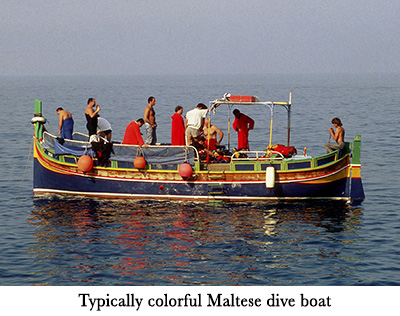 Malta's most impressive wreck is the 110m Libyan oil tanker El Farouk, which was sunk as an indirect result of a 1998 explosion killing nine workers while in dry dock. It was towed out and sunk off the western side of Malta. Now broken in two amidships, both halves sit upright on a sandy bottom at 34m. It's a big ship with an impressive bow, and we dived it twice, covering the forward and aft sections separately, penetrating the bridge and holds. Like all the Maltese wrecks, it had been stripped before scuttling, so the passageways, bridges, and holds are empty. Hard fittings, such as pipes, remain. Despite that, it's an impressive wreck to dive.
Malta's most impressive wreck is the 110m Libyan oil tanker El Farouk, which was sunk as an indirect result of a 1998 explosion killing nine workers while in dry dock. It was towed out and sunk off the western side of Malta. Now broken in two amidships, both halves sit upright on a sandy bottom at 34m. It's a big ship with an impressive bow, and we dived it twice, covering the forward and aft sections separately, penetrating the bridge and holds. Like all the Maltese wrecks, it had been stripped before scuttling, so the passageways, bridges, and holds are empty. Hard fittings, such as pipes, remain. Despite that, it's an impressive wreck to dive.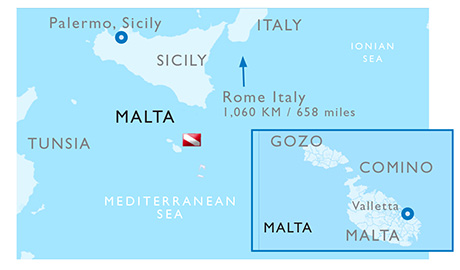 Tourists throng to Malta in July and August, so the best time of the year to dive is spring/early summer or late summer/autumn. Daytime temperatures in late May ran from the high 70ºs to the low 80ºs, but summer is hot and busy, with more divers -- mostly English, German and Malta expats -- and less personalized service, but even early in the season, there were significant numbers of divers. The water was surprisingly cool -- 61ºF -- but visibility was good. In summer, the water reaches the mid-70ºs at the surface, but visibility might be lower than the 35-70 feet I experienced. The Mediterranean is extremely deep, and plankton falls away from the surface, meaning visibility can often be better than just about anywhere. More than 100 feet is common.
Tourists throng to Malta in July and August, so the best time of the year to dive is spring/early summer or late summer/autumn. Daytime temperatures in late May ran from the high 70ºs to the low 80ºs, but summer is hot and busy, with more divers -- mostly English, German and Malta expats -- and less personalized service, but even early in the season, there were significant numbers of divers. The water was surprisingly cool -- 61ºF -- but visibility was good. In summer, the water reaches the mid-70ºs at the surface, but visibility might be lower than the 35-70 feet I experienced. The Mediterranean is extremely deep, and plankton falls away from the surface, meaning visibility can often be better than just about anywhere. More than 100 feet is common.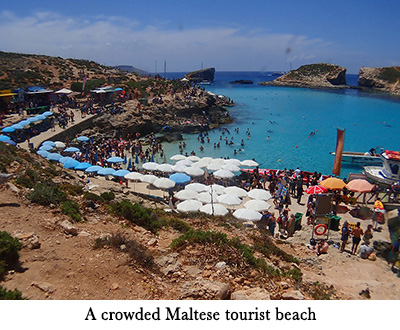 We swam out to the first tug, which was sitting upright on a sand bottom at 69 feet. Not a big boat (66 feet long), but enough for my first dive. All the external surfaces were thick with seaweed and fish were few, as is the case in the Central Mediterranean. But on various dives, I did see banded sea bream, damselfish, wrasses, jellyfish, mullet, and even a moray eel. The second tug was much the same. When we came back, it was not easy getting out, and other divers had to be helped due to the swell.
We swam out to the first tug, which was sitting upright on a sand bottom at 69 feet. Not a big boat (66 feet long), but enough for my first dive. All the external surfaces were thick with seaweed and fish were few, as is the case in the Central Mediterranean. But on various dives, I did see banded sea bream, damselfish, wrasses, jellyfish, mullet, and even a moray eel. The second tug was much the same. When we came back, it was not easy getting out, and other divers had to be helped due to the swell.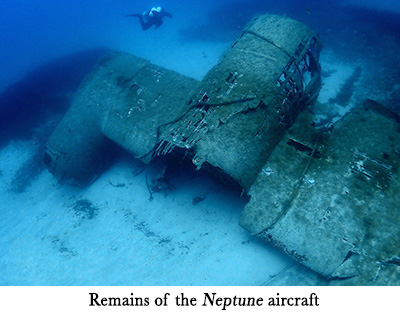 Malta itself is a busy place, with about 1.6 million tourists (three times the population) a year seeking the sun. They flock to the few beaches along the rocky coastline or take boat trips to the blue grotto and lagoon, visit the architectural remains from earlier inhabitants, the many churches, the aquarium (near NDS), or go shopping and eating in restaurants. There is also a pub/party/disco scene in Valletta. Alternatively, tourists who seek a quieter, more rural environment head to Gozo, which has at least one dive shop.
Malta itself is a busy place, with about 1.6 million tourists (three times the population) a year seeking the sun. They flock to the few beaches along the rocky coastline or take boat trips to the blue grotto and lagoon, visit the architectural remains from earlier inhabitants, the many churches, the aquarium (near NDS), or go shopping and eating in restaurants. There is also a pub/party/disco scene in Valletta. Alternatively, tourists who seek a quieter, more rural environment head to Gozo, which has at least one dive shop.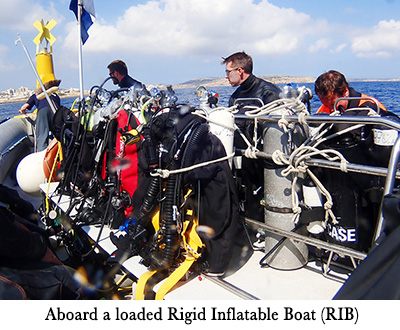 It was a long trek down, which I did in two stages, carrying the tank separately rather than on my back with the rest of the gear. This was hard; I'm getting older, and my knees are not good. In Malta, it's not valet diving, where everything is done for you. Jasper, however, was patient and willing to assist when asked.
It was a long trek down, which I did in two stages, carrying the tank separately rather than on my back with the rest of the gear. This was hard; I'm getting older, and my knees are not good. In Malta, it's not valet diving, where everything is done for you. Jasper, however, was patient and willing to assist when asked. Divers Compass: Two other budget hotels in the area are Topaz Hotel and Tarona Guesthouse. For more upmarket diving and accommodations, I suggest DiveWise and the Westin Dragonara Resort ... My costs for the week were: diving EUR500 ($551) meals and accommodation EUR500 ($551), taxi EUR50 ($55), total EUR1,050 ($1,156) ... DiveWise
Divers Compass: Two other budget hotels in the area are Topaz Hotel and Tarona Guesthouse. For more upmarket diving and accommodations, I suggest DiveWise and the Westin Dragonara Resort ... My costs for the week were: diving EUR500 ($551) meals and accommodation EUR500 ($551), taxi EUR50 ($55), total EUR1,050 ($1,156) ... DiveWise 